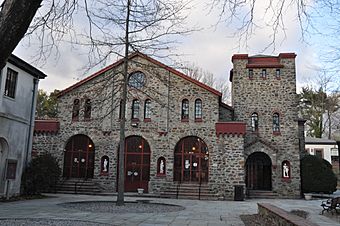Rosemary Hall (Greenwich, Connecticut) facts for kids
Quick facts for kids |
|
|
Rosemary Hall
|
|
 |
|
| Location | Jct. of Ridgeway and Zaccheus Mead Ln., Greenwich, Connecticut |
|---|---|
| Area | 18 acres (7.3 ha) |
| Built | 1909 |
| Architect | Blake, Theodore E. |
| Architectural style | Renaissance, Gothic Revival |
| NRHP reference No. | 90001137 |
| Added to NRHP | August 28, 1998 |
Rosemary Hall was a special school just for girls. It was located in Greenwich, Connecticut. Later, it joined with a boys' school called Choate. Together, they became Choate Rosemary Hall. The school then moved to the Choate campus in Wallingford, Connecticut.
The Greenwich campus of Rosemary Hall opened in 1900. The oldest building still standing there was built in 1909. This campus was added to the National Register of Historic Places in 1998. It was recognized for its beautiful architecture. The site includes 16 important buildings and one other structure. The whole area is about 18 acres. Today, the Carmel Academy and The Japanese School of New York use this campus for their classes.
Contents
School Leaders and History
Early Days of Rosemary Hall
Rosemary Hall was started in 1890 by Mary Atwater Choate. It began at Rosemary Farm in Wallingford, Connecticut. This farm was Mary's childhood home. Mary Choate had also helped start a group for women who lost their husbands in the Civil War. She wanted to create a new school to help girls become independent.
In 1889, Mary looked for a headmistress. She wanted someone to run a school that would teach girls "domestic arts." This meant skills for running a home. Caroline Ruutz-Rees, a 25-year-old teacher from Britain, answered the advertisement.
The school officially opened on October 3, 1890. Eight girls were the first students. They lived on the second floor of the school building. Classrooms were on the ground floor. The dining room was in the basement. Soon, more space was needed. The school rented other houses nearby.
Caroline Ruutz-Rees: A Strong Leader
Caroline Ruutz-Rees (1865–1954) was the headmistress until 1938. She was a very strong and influential person. She believed strongly in women's rights. She even wore bloomers on the golf course, which was shocking at the time! She also carried a pistol on buggy rides. Her motto was "No rot," meaning she expected high standards.
Caroline quickly changed the school's focus. Instead of just "domestic arts," she made it more like a challenging boys' school. Her teaching plan had three main parts:
- Students learned to govern themselves.
- Girls played contact sports.
- They had very challenging academic studies.
Ruutz-Rees taught history, French, and classical languages like Latin and Greek. In 1897, she was the first headmistress in America to require school uniforms for girls. The Rosemary Hall uniform became very fancy over time. It included a cape and star-shaped berets. The school also had many special traditions. Teachers wore academic robes and called students by their last names. Ruutz-Rees herself always wore blue silk dresses and an amber bead necklace.
Moving to Greenwich
In 1896, the Choate School for boys was founded nearby. It was started by Mary Choate and her husband, William. There was no official link between the two schools. But students from both schools sometimes met for plays and dances.
Over time, Caroline Ruutz-Rees and Mary Choate had different ideas about the school. By 1900, parents of students who liked Ruutz-Rees's style helped her. Two parents from Greenwich, Connecticut, worked to move the school to their town. Greenwich was a wealthy area not far from New York City.
A shipping owner named Nathaniel Witherell gave 5 acres of land in Greenwich. Other people invested money to help move the school. Ruutz-Rees became the main owner. Rosemary Hall opened in Greenwich in the fall of 1900. There were 57 girl students. They moved into the main building, called "The School." It was a U-shaped house. The campus also had a gym, a tennis court, and a running track. Over the next 20 years, more buildings were added. An Italian garden was also built in 1912.
The heart of the campus was St. Bede's Chapel. It was built with money raised by students and the school community. Construction started in 1906. The chapel was officially opened on October 18, 1909. St. Bede's Chapel was built in a Middle English Gothic style. It had stone walls, a slate roof, and a special altar window. The girls themselves helped build it. They collected stones and carried them to the building site. From 1915 to 1965, the name of every graduate was painted in gold on the chapel ceiling.
Important Dates
- 1889: Mary Atwater Choate looks for a headmistress.
- 1890: The school is founded by Mary Atwater Choate. Caroline Ruutz-Rees becomes headmistress. Eight girls enroll.
- 1891: The first "Optima" (best girl) is chosen. This honor continued until 1977.
- 1892: The first student literary magazine, The Question Mark, is published.
- 1893: Rosemary Hall hosts Mrs. Hazen's School. This is thought to be the first sports event between girls' schools in America.
- 1894: The first interscholastic basketball game is played.
- 1895: The first "Sixth Form Walk" takes place. Girls walked about 45 miles in three days.
- 1896: 20 girls are enrolled. Frederick Hulseberg becomes the first girls' cricket coach in America.
- 1897: The student self-governance group, "The Committee," is first elected. It lasted until 1971.
- 1898: Older students had to pass a college entrance exam to graduate.
- 1900: The school moves to Greenwich. There are 57 girls.
- 1907: Mary Elizabeth Lowndes begins teaching. She later becomes a co-headmistress.
- 1908: The yearbook, The Answer Book, is first published.
- 1909: St. Bede's Chapel is officially opened.
- 1910: Lady Baden-Powell, wife of the Boy Scouts founder, gives Caresse Crosby '11 an award. This makes her the unofficial first American Girl Scout.
- 1911: The Kindly Club is founded to promote kindness and charity.
- 1918: The first Garden Party is held. This event continues today.
- 1923: The Main Building burns down. All school records are lost.
- 1924: The Main Building is rebuilt. 200 girls enroll.
- 1928: The school's field hockey team starts a three-year winning streak.
- 1937: Life magazine features the annual "The Mid" dance. Girls invited boys from colleges like Yale and Harvard.
- 1938: Ruutz-Rees retires as headmistress. Eugenia Baker Jessup '10 becomes headmistress.
- 1950: The school becomes the Rosemary Hall Foundation. An experiment called "Operation X" allows 10 older students to be free from most school rules.
- 1954: Headmistress emeritus Ruutz-Rees passes away.
- 1958: Alice McBee becomes headmistress. The Whimawehs a cappella singing group begins.
- 1962: The Ruutz-Rees Auditorium opens.
- 1965: Actress Glenn Close graduates.
- 1966: The school begins to admit African-American students.
- 1967: The headmistress suggests joining with a boys' school due to fewer students and money problems.
- 1968: Discussions begin with Choate School about Rosemary Hall moving to their campus.
- 1969: Architect James Polshek is chosen to design the new campus in Wallingford.
- 1971: The last Prize Day is held in Greenwich. The school and 223 girls move to Wallingford. The Greenwich campus is bought by Daycroft School.
Famous Alumni
Many talented women attended Rosemary Hall. Here are a few:
- Neile Adams, an actress, singer, and dancer.
- Glenn Close, a famous actress who has been nominated for many awards.
- Caresse Crosby, a socialite, poet, and publisher.
- Claire Giannini Hoffman, the first woman to serve on the boards of major companies like Bank of America.
- Sarah Kernochan, a novelist, screenwriter, and director who has won two Oscars.
- Ali MacGraw, an actress and model.
- Terry O'Neill, a feminist leader and president of the National Organization for Women (NOW).
Images for kids
-
Caresse Crosby '11, with her husband Harry Crosby. She was a poet and publisher.
-
Ali MacGraw '55, a Golden Globe-winning actress.
-
Glenn Close '65, an Emmy and Tony Award-winning actress.






